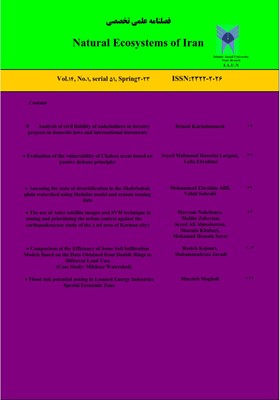The use of Aster satellite images and SVM technique in zoning and prioritizing the urban context against the earthquakes (case study of the 5 nd area of Kerman city)
Subject Areas : civil programing
Maryam Nohe sara
1
,
Malihe Zakeriyan
2
*
,
Seyad Ali Almodaresi
3
![]() ,
Mostafa Khabazi
4
,
Mohamad Hosin Sarai
5
,
Mostafa Khabazi
4
,
Mohamad Hosin Sarai
5
1 - PhD student in Geography and Urban Planning, Islamic Azad University, Yazd Branch, Yazd, Iran.
2 - 2- Faculty Member, Department of Geography and urban planning, Islamic Azad University, Miybod azd Branch, Iran
3 - Professor of Geomorphology, Department of Geography and Urban Planning, Islamic Azad University, Yazd Branch, Yazd, Iran.
4 - Associate Professor of Geomorphology, Shahid Bahonar University of Kerman. Kerman, Iran.
5 - Professor, Department of Geography and Urban Planning, Yazd University. Yazd, Iran
Keywords: Earthquake, Vulnerability, Worn Texture, remote sensing, Vector Machine Classification,
Abstract :
Iran is one of the ten earthquake-prone countries and the sixth earthquake-prone country in the world. The city of Kerman, as the center of the country's largest province, is no exception to this rule, with a lot of worn-out urban fabric. The city of Kerman is located on the northern edge of the Kerman Plain as a thrust subduction (graben) along with numerous faults on the border between the mountains and the plain and the areas near the city, some of which can cause earthquakes even stronger than 7. Richter. The worn-out urban texture has also added to it. Today, the vulnerability of cities to earthquakes has become an important issue for environmental risk experts. In this research, using ASTER satellite images of 2007, the worn-out textures of Kerman city were identified using SVM. In this study, the kappa coefficient of 76% was determined for all classes and the kappa coefficient of 59% was identified in Kerman. The results showed that the support vector machine classification method has the ability to detect nearly 45% of the worn tissue of the area. This identification showed that the support vector machine method could not work very well in identifying the area of five worn-out urban fabrics. As a result, the heritage of the area was identified with the control points in the worn-out fabric by field investigation and matching Google images. Due to the existence of many barren lands in this area and the spectral similarity of the barren land with worn-out texture, the support vector machine method could not provide proper identification.
_||_

